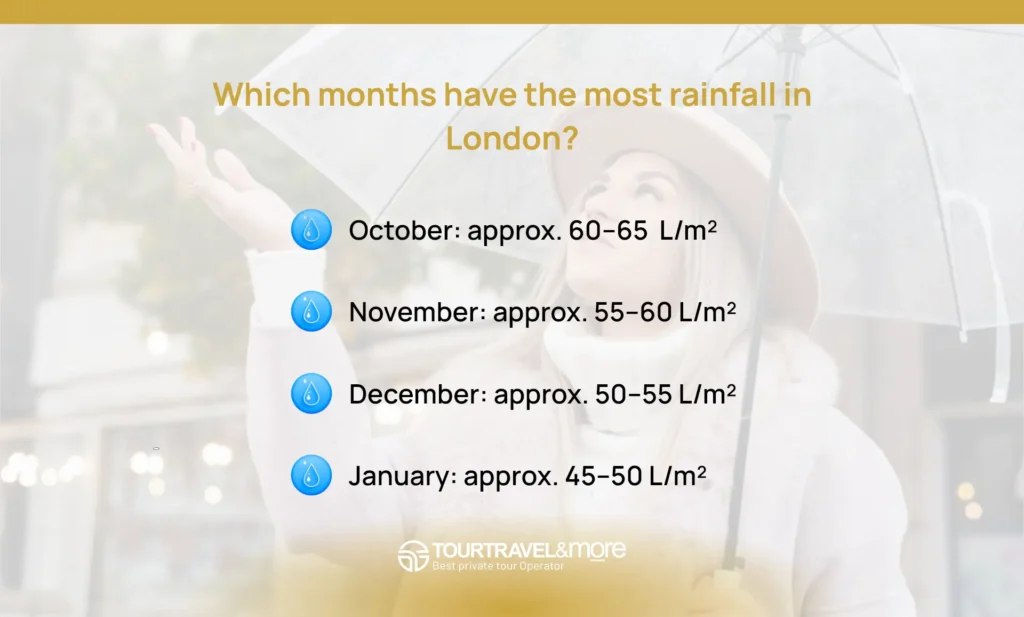London is a city famous for its history, landmarks, and… its weather. Many travelers wonder if it’s a good idea to visit because of the rain, or which is the best month to avoid getting soaked. Although British weather has a reputation for being gray and wet, the reality is much more nuanced.
In this guide, you’ll discover which month sees the most rainfall in London, what the climate is like month by month, and what to pack so the weather doesn’t ruin your trip.
Does it rain all year in London?
This is one of the most common myths among those planning their first trip to the British capital. The idea that “it always rains in London” is so widespread that many accept it as an absolute truth. However, according to real meteorological data, not every month has the same amount of rainfall, and it certainly doesn’t rain all day.
London does get frequent rain, but it is mostly light drizzles and occasional showers, not long, intense storms. It is completely possible to explore the city with a good folding umbrella and a raincoat.
What is the rainiest month in London?
According to annual climate statistics, the months with the most rainy days in London are October and November, followed closely by January and December.
If we look at the total amount of rainfall, the average monthly data is as follows:

This means that October is usually the rainiest month, both in terms of volume and frequency, although November is very close behind. December and January also have plenty of damp days, though the total monthly rainfall is a bit lower.
In all cases, it is mostly light and continuous rain rather than heavy storms. It’s rare for rain to actually prevent you from going out or getting around the city.
Month by month: what is the weather like in London throughout the year?
London’s climate changes gradually with the seasons. Here’s a general overview:
| Month | Climate and Recommendations |
|---|---|
| January | Mid-winter, cold (2°C – 8°C), frequent rain and very short days. |
| February | Continued winter with similar temperatures. Cold and damp, limited daylight. |
| March | Transition towards spring (5°C – 11°C), unstable weather, dress in layers. |
| April | Spring blooms (9°C – 15°C), lots of rain, umbrella is essential. |
| May | Pleasant temperatures (11°C – 18°C), spring-like and sunny atmosphere. |
| June | High summer (14°C – 22°C), long and generally dry days. |
| July | Peak summer (15°C – 23°C), ideal for outdoor activities. |
| August | Warmest month (16°C – 24°C), though occasionally rainy. |
| September | Transition to autumn (13°C – 19°C), mix of warmth and light rain. |
| October | Rainiest month (10°C – 15°C), perfect for autumn walks if you enjoy the season. |
| November | Temperatures drop (7°C – 12°C), shorter days, frequent rain. |
| December | Winter chill (3°C – 8°C), Christmas markets and city lights, typical winter rain. |
October and November: the months with the most rainy days
Autumn in London is magical: parks covered in reddish leaves, a tranquil atmosphere, and cozy cafes. But it also brings plenty of rain.
During these two months, it’s common to have rain for one or even two entire weeks—sometimes intermittent, sometimes persistent. You shouldn’t expect storms, but rather constant humidity, drizzle, and gray skies. Still, many consider this one of the best times to explore London, if you come prepared.
Is it worth visiting London during the rainy season?
Absolutely. Rain in London does not stop life or tourist experiences. Museums, pubs, galleries, covered markets, musicals—all remain open and just as charming.
Also, visiting the city in months like October or February has its advantages: fewer tourists, lower prices, and a more authentic atmosphere.
What clothes and accessories to pack if you’re traveling in rainy months
The key is to dress in layers. This allows you to adapt easily to changes in temperature and humidity. Based on the experience of frequent travelers, it’s recommended to bring:
- Waterproof coats or trench coats
- Thermal underwear if traveling in winter
- Light jackets for autumn or spring
- A folding umbrella, sturdy enough for the wind
- Waterproof and comfortable walking shoes
- Scarf, hat, and gloves if visiting between November and February
A useful tip: avoid shoes with smooth soles or absorbent materials. Sidewalks can stay wet for hours.
Practical tips for enjoying London… even in the rain
- Take advantage of indoor activities: London has more than 170 museums, many of them free
- Get an Oyster Card to travel easily on the Tube and buses, rain or shine
- Plan covered routes: markets like Borough Market or Mercato Mayfair are excellent options
- Enjoy the pubs: warm, great food, and perfect for sheltering for a while
- Check the daily forecast: the weather changes quickly, but forecasts help you plan
Don’t let the weather stop your trip to London
Traveling to London at any time of year is possible and highly recommended. Although October is the rainiest month, the city is well prepared so you barely notice it. With the right clothes, an umbrella handy, and an open mind, rain becomes part of the charm.
Beyond gray skies, London shines with vibrant markets, nostalgic parks, living history, and corners best explored on foot—even in the rain.
Don’t let the weather make your decision for you. Let it be your desire to discover one of the most fascinating cities in the world.



